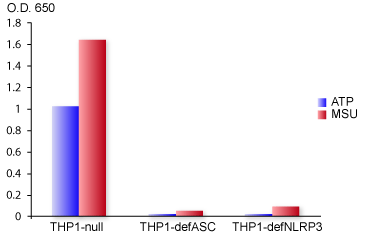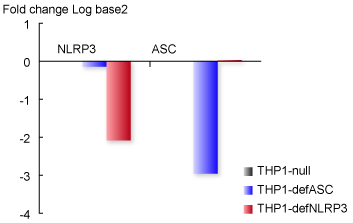THP1-Null Cells
| Product | Unit size | Cat. code | Docs. | Qty. | Price | |
|---|---|---|---|---|---|---|
|
THP1-Null Cells Positive control cell line for inflammasome studies |
Show product |
3-7 x 10e6 cells |
thp-null
|
|
||
|
THP1-Null vial Additional cell vial |
Show product |
3-7 x 10e6 cells |
thp-null-av
|
Notification: Reference #thp-null-av can only be ordered together with reference #thp-null.
Positive control cell line for inflammasome studies
THP1-Null cells are derived from THP-1 human monocytic cells, that represent the most commonly used model cell line for the study of inflammasome activation as they express high levels of NLRP3, ASC and pro-caspase-1.
![]() More details on THP1-Null cells
More details on THP1-Null cells
THP1-Null cells produce IL-1β upon stimulation with inflammasome inducers, such as MSU crystals and ATP.
As THP1-Null cells are fully efficient for NLRP3 and ASC activities, they are the positive control cell line for THP1-defASC and THP1-defNLRP3, that are deficient in ASC and NLRP3 respectively.
![]() Download our Practical guide on Inflammasomes
Download our Practical guide on Inflammasomes
Specifications
Antibiotic resistance: hygromycin B
Growth Medium: RPMI 1640, 2 mM L-glutamine, 25 mM HEPES, 10% heat-inactivated fetal bovine serum, 100 μg/ml Normocin™, Pen-Strep (100 U/ml-100 μg/ml)
Guaranteed mycoplasma-free
Quality control:
- The functionality of THP1-Null cells was tested using inflammasome inducers, such as MSU crystals and ATP.
Contents
- 1 vial containing 3-7 x 106 cells
- 1 ml of Hygromycin B Gold (100 mg/ml)
- 1 ml of Normocin™ (50 mg/ml)
![]() Shipped on dry ice (Europe, USA, Canada and some areas in Asia)
Shipped on dry ice (Europe, USA, Canada and some areas in Asia)
Back to the top
Details
THP1-Null cells are designed to study the signals involved in inflammasome activation. To become susceptible to inflammasome inducers, these cells must be induced by stimuli commonly used for induction in model systems, such as lipopolysaccharide (LPS) and phorbol 12-myristate acetate (PMA). Stimulation by LPS or differentiation with PMA induces the production of pro-IL-1β, the immature form of IL-1β. Subsequent stimulation with inflammasome inducers, such as ATP and alum, leads to caspase-1 activation and IL-1β maturation and secretion. Mature IL-1β can be detected by Western blot, ELISA, or a cell-based assay.
InvivoGen has developed a new method to detect bioactive IL-1β, based on HEK293 cells specifically engineered to selectively respond to IL-1β, named HEK-Blue™ IL-1β. These cells feature the SEAP (secreted embryonic alkaline phosphotase) reporter gene under the control of an NF-kB-inducible promoter. They naturally express the IL-1β receptor (IL-1R), and all the proteins involved in the MyD88-dependent IL-1R signaling pathway that leads to NF-kB activation. Thus upon IL-1β binding to IL-1R, a signaling cascade is initiated triggering NF-kB activation and the subsequent production of SEAP. Detection of SEAP in the supernatant of HEK-Blue™ IL-1β cells can be readily assessed using QUANTI-Blue™ Solution, a SEAP detection medium. QUANTI-Blue™ Solution turns blue in the presence of SEAP which can be easily quantified using a spectrophotometer.
Back to the top







